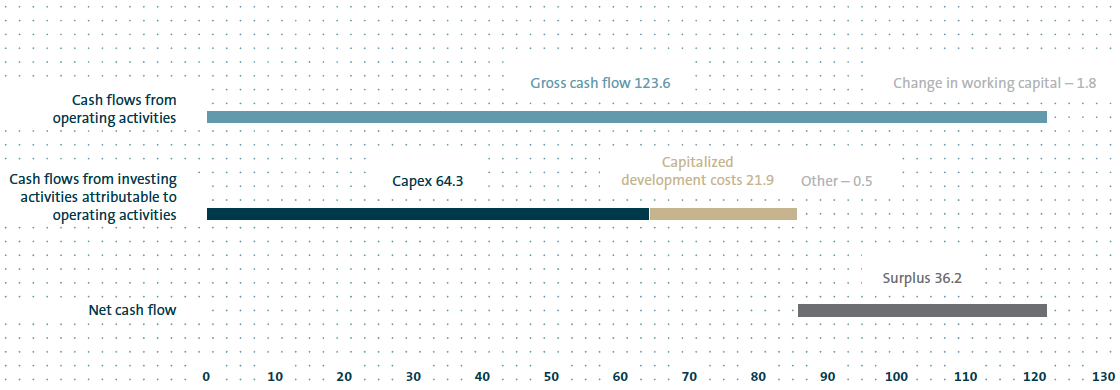Investment- and financial planning
INVESTMENT- AND FINANCIAL PLANNING 2015 to 2019 IN THE AUTOMOTIVE DIVISION
€ billion
In our current planning, investments of a total of €85.6 billion will be made in the Automotive Division in the period from 2015 to 2019. Investments in property, plant and equipment, investment property and intangible assets, excluding capitalized development costs (capex), will account for €64.3 billion, more than half of which (roughly 56%) will be in Germany alone. The ratio of capex to sales revenue in the period from 2015 to 2019 will be at a competitive level of 6 – 7%. Besides capex, investing activities will include additions of €21.9 billion to capitalized development costs. Among other things, these reflect upfront expenditures in connection with compliance with environmental standards and the extension and updating of our model range. The investments in new facilities and models, as well as in the development of alternative drives and modular toolkits, are laying the foundations for profitable, sustainable growth at Volkswagen. These investments also include commitments arising from decisions taken in previous fiscal years.
At €41.3 billion (roughly 64%), the majority of the total capex in the Automotive Division will be spent on modernizing and extending the product range for our brands. The spotlight will be on the expansion of the SUV range, especially in the A and A0 segments, as well as on modernizing the range of light commercial vehicle models. A parallel focus will be on new vehicles and successor models in almost all vehicle classes, which will be based on the modular toolkit technology and the related components. This will allow us to systematically continue our model rollout with a view to tapping new markets and segments. In the area of drivetrain production, we will launch new generations of engines offering improved performance and lower fuel consumption and emission levels, while at the same time driving forward the development of hybrid and electric drives.
In addition, Volkswagen will make cross-product investments of €23.0 billion over the next five years, primarily in environmentally friendly production. These will include, for example, investments to expand capacity, a new plant in Poland for production of the Crafter and the new Audi manufacturing facility in Mexico. As a result of our high quality targets and our commitment to continuous improvement of our production processes, investments in our press shops and paintshops are also necessary. Non-production-related investments are mainly planned for the areas of development, quality assurance, sales, genuine parts supply and information technology.
We intend to finance our investments in the Automotive Division using internally generated funds and expect cash flows from operating activities to amount to €121.8 billion over the 2015 to 2019 planning period. This means that the funds generated are expected to exceed the Automotive Division’s investment requirements by €36.2 billion, further improving our liquidity position. We expect net cash flow in the Automotive Division to be moderately lower in 2015 than in the prior year, but it will nevertheless make a significant contribution to strengthening the Group’s financial position.
These plans are based on the Volkswagen Group’s current structures. They do not take into account the possible settlement payable to other shareholders associated with the control and profit and loss transfer agreement with MAN SE. Our joint ventures in China are not consolidated and are therefore also not included in the above figures. These joint ventures will invest a total of €22.0 billion in new production facilities and products in the period from 2015 to 2019 and will finance these investments from the companies’ own funds.
We are planning to invest €2.8 billion in the Financial Services Division from 2015 to 2019. We expect the growth in lease assets and in receivables from leasing, customer and dealer financing to lead to funds tied up in working capital of €94.9 billion. Roughly 42% of the total capital requirements of €97.7 billion will be financed from gross cash flow. As is common in the sector, the remaining funds needed will be met primarily through established money and capital market debt issuance programs and customer deposits from the direct banking business.
